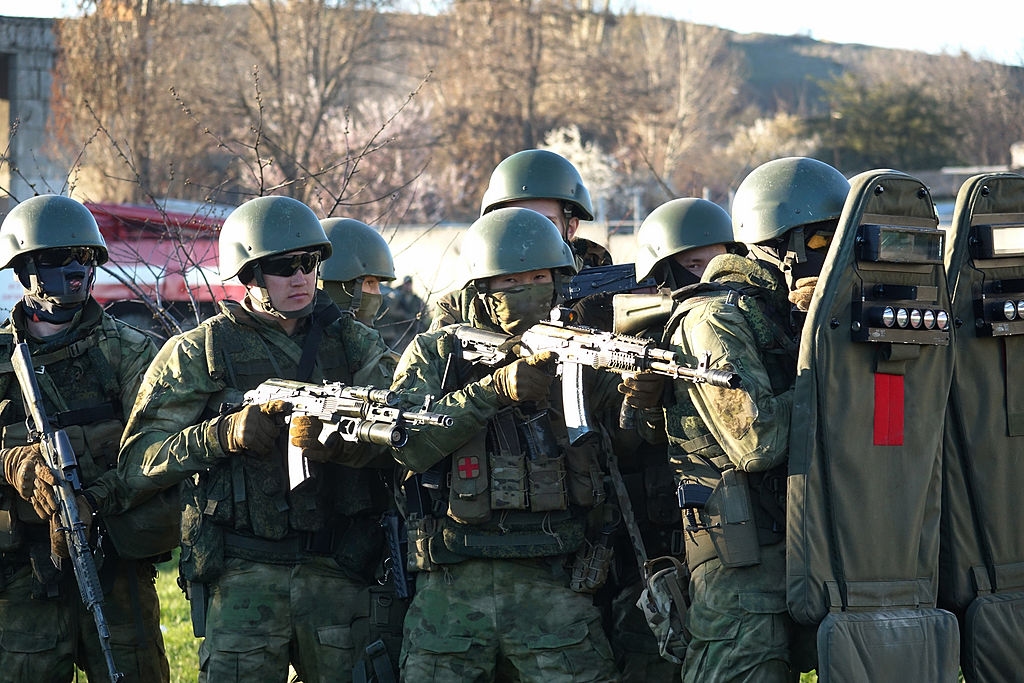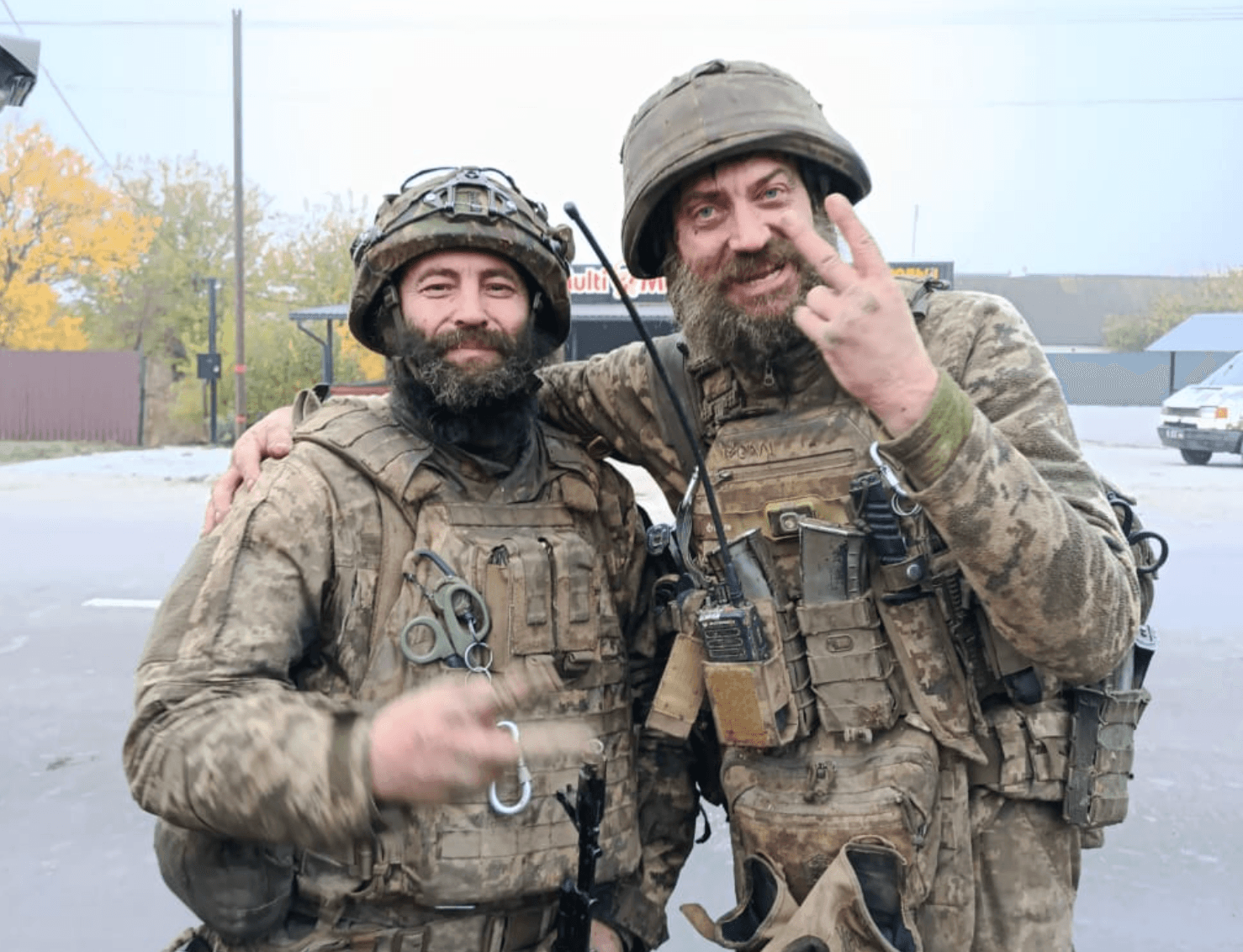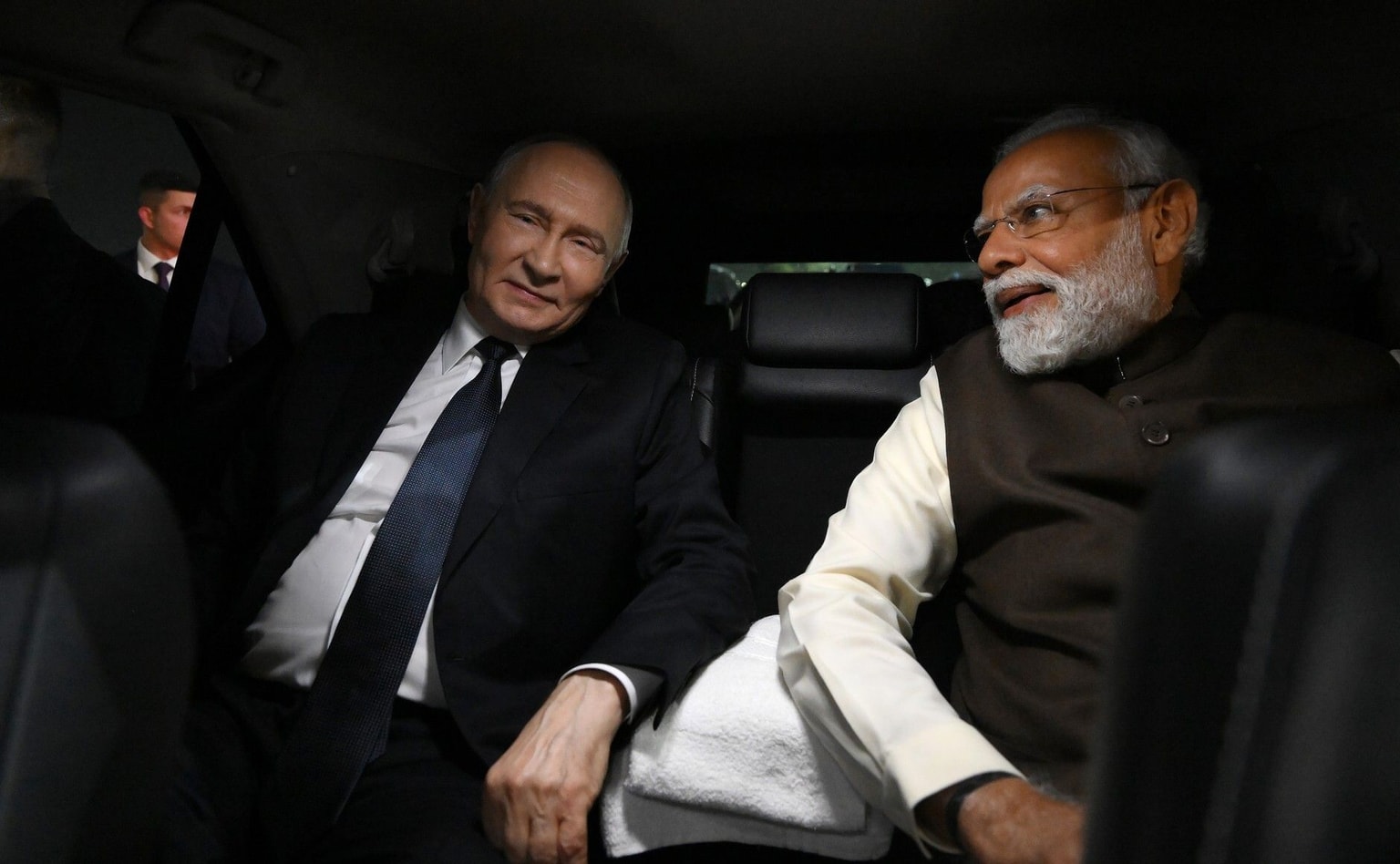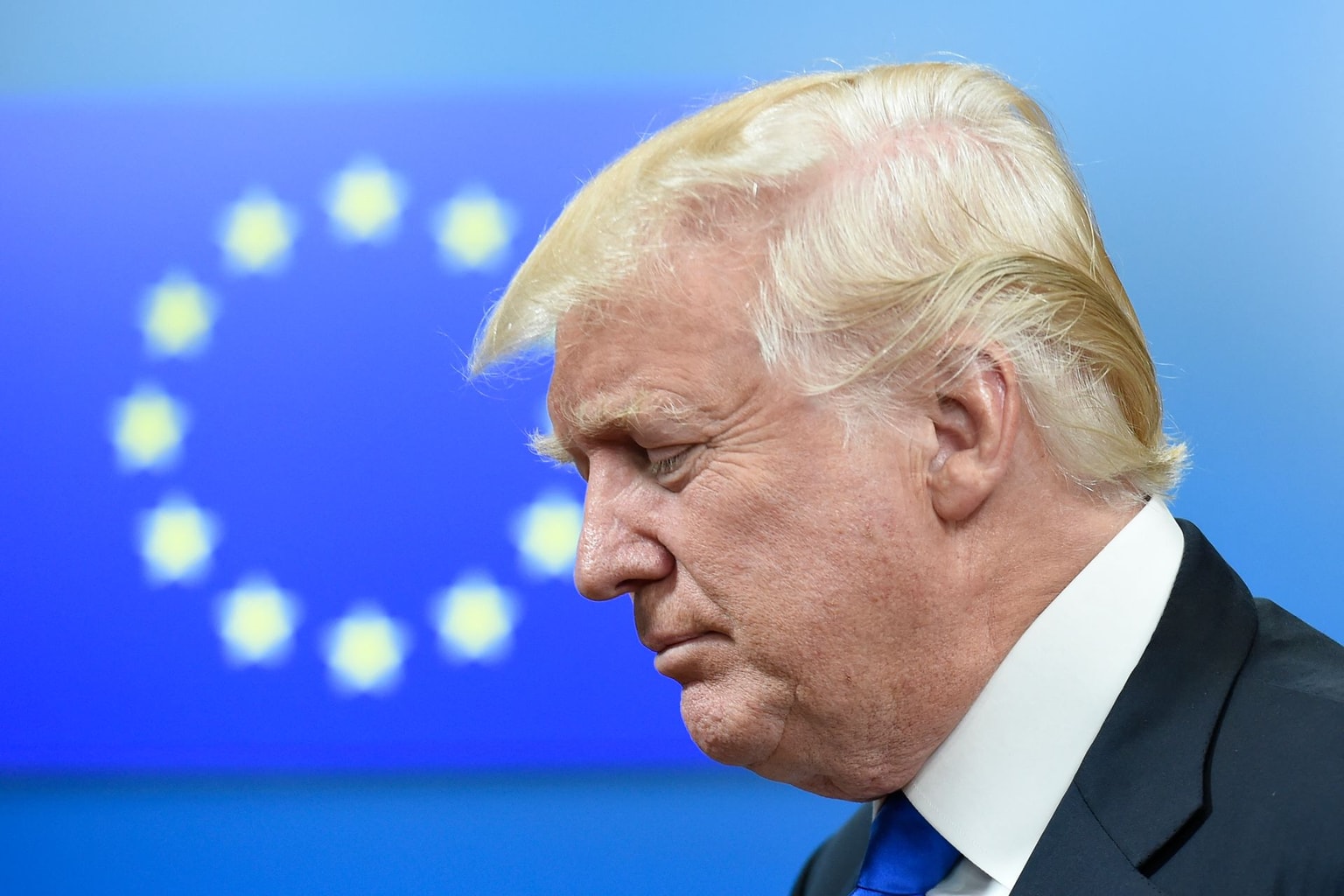People hold a huge flag, a combination of Ukrainian, Crimean, and Tatar flags, on Independence Square in Kyiv, Ukraine, on March 23, 2014 following Russia's illegal annexation of Crimea. (Sergei Supinsky / AFP via Getty Images)
Amid reports that a U.S. peace proposal might include recognizing Moscow's illegal annexation of Crimea, President Donald Trump denied Ukraine was being pressured to accept the move — while also asserting Ukraine had given up the peninsula in 2014 "without firing a shot."
"Nobody is asking (President Volodymyr) Zelensky to recognize Crimea as Russian territory, but if he wants Crimea, why didn't they fight for it eleven years ago when it was handed over to Russia without a shot being fired?" Trump wrote on his Truth Social platform on April 23.
The claim that Ukraine simply handed over Crimea when Russia illegally annexed the peninsula in February 2014 ignores years of Moscow's military buildup in the region and the volatile political crisis occurring in Ukraine at the time that left Kyiv ill-equipped to mount a defense.
Russia’s annexation of Crimea coincided with the Euromaidan Revolution, widely considered the single most consequential political event in Ukraine's independent history that ended with the ousting of then pro-Russian President Viktor Yanukovych.

After Yanukovych ordered his security forces to open fire on protestors, killing around 100 people, he fled the country to Russia on Feb. 21, 2014. In the power vacuum left by his departure, Moscow moved to take over Crimea.
The Kremlin had been amassing troops in Crimea for years thanks to agreements that had allowed it to station its Black Sea Fleet on the peninsula. This military presence enabled Moscow to take swift control over Crimea in less than a month.
Russian special forces without insignia seized the building of the Supreme Council and the Crimean Ministers Council overnight on Feb. 27, 2014. A few weeks later, Russian soldiers took control of airports, Ukrainian military units, and the navy. While the takeover was largely without armed resistance, Ukrainian troops stationed at the Balbek Air Base did put up a fight against Russian troops.

A total of 103 cadets, 2,239 soldiers and sailors, and 1,649 officers of the Ukrainian Armed Forces held out for almost a month in a complete Russian encirclement in Crimea, then-acting Ukrainian President Oleksandr Turchynov wrote recently on his personal website on April 14 in response to claims that the Ukrainian soldiers stationed in Crimea had not been commanded to defend their positions.
Meanwhile, the U.S. and the U.K. — signatories of the 1994 Budapest Memorandum, which pledged to uphold Ukraine's territorial integrity in exchange for Kyiv surrendering its nuclear arsenal — did not come to Ukraine's defense. The agreement has been widely criticized for its vague political guarantees rather than firm commitments to protect Ukraine in the case of armed aggression.
“They explained that they didn't want to irritate Vladimir Putin or provoke a full-scale war in the heart of Europe. Ukraine wasn't given a single bullet,” Turchynov recalled.
Russia's long-term plan
Russia began taking its first steps toward its future occupation of Crimea long before 2014, helped along by the government of Yanukovych.
The Kharkiv agreements, signed by Yanukovych and then-Russian President Dmitry Medvedev on April 21, 2010, extended Russia's lease to station its Black Sea Fleet in Sevastopol until 2042. The agreements signed that year also lifted any restrictions on Russian troops' movements around the peninsula, "creating all the necessary prerequisites for occupation," Turchynov wrote.

The increase in the Russian fleet's presence, whose troops and military equipment exceeded that of Ukraine's in Crimea, was supposed to be in exchange for cheaper Russian gas for Ukraine by applying a discount in the form of canceling customs duties. The deal, however, threatened Ukraine's sovereignty.
"This was a threat, because at any time, this group (of forces) could have launched wider-scale actions against our country," Vadym Skibitskyi, deputy head of Ukraine's military intelligence agency (HUR), told Radio Free Europe/Radio Liberty (RFE/RL) in 2021.
Between 2010 and 2014, Russia began covertly bringing in modernized or refurbished equipment into Crimea to strengthen its military forces, according to Ukrainian intelligence (HUR). The agency also recorded incidents when Russia seized Ukrainian navigation equipment in 2011 and 2012.
Russian troops were also actively forming new brigades on the Crimean peninsula. At the same time, the Ukrainian army had been experiencing long-lasting funding cuts. An ongoing reform of the army resulted in the disbanding of the 32nd Army Corps and the withdrawal of the 3rd Separate Special Forces Regiment, both of which were stationed in Crimea.
Under the presidency of Viktor Yushchenko from 2005-2010, the issue of the Ukrainian military's combat capability and potential NATO membership was regularly raised. These discussions came to a standstill under Yanukovych.
Toward the end of his presidential term, Yushchenko said in 2009 that the Ukrainian army had become a "victim of political intrigue," hinting that disagreements within the government had led to the impoverishment of the military.

The situation around the peninsula heated up even more in late 2013. On the eve of the Olympic Games in Sochi, a city on the Black Sea coast, Russia announced the need to conduct additional security measures in the water to ensure safety during the sporting event.
"Using this legend, the Russian military practiced blocking maritime waters, as well as the airspace, and conducted various reconnaissance operations. They used reconnaissance and long-range radar detection aircraft. They also conducted aggressive reconnaissance activities against Ukraine," Skibitskyi told RFE/RL.
In late February 2014, Russian airborne troops from regions including Tula, Ryazan, and Kubinka were reportedly put on high alert and began movement toward the Black Sea coast.
Ukraine had little capability to respond at that point.
Losing precious time
The Kremlin began its occupation of Crimea while Kyiv was in chaos after Yanukovych fled to Rostov-on-Don following the EuroMaidan. Instead of organizing the defense of Crimea, pro-Russian associates of the former president were also busy fleeing Ukraine.
"The entire policy of Yanukovych started to fall into place: it weakened the Ukrainian state, paving the way for both the forthcoming annexation of Crimea and the attempt to separate the eastern and southern oblasts from the rest of the country," a report by the Warsaw Institute published in 2018 read. Russia launched an invasion of Ukraine's eastern regions with the use of proxies after it annexed Crimea, and attempted to sow instability in the south.
After an interim government was set up in Kyiv, a secret meeting of Ukraine's National Security and Defense Council was held on Feb. 28, 2014, almost a week after Russian forces began their operation on the peninsula.
The participants decided to put the Ukrainian Armed Forces on full combat alert, appeal to the Budapest Memorandum guarantor countries, strengthen the defense of critical infrastructure, and create an operational headquarters for responding to the situation in Crimea.
The decisions did little to drive Russia off the peninsula.
Ukrainian admiral Denys Berezovskyi took over the Ukrainian Navy on March 1, 2014. The next day, he refused to comply with the Ukrainian authorities' orders, issuing one himself to subordinate units in Crimea military personnel to hand over their weapons to the warehouses and return military equipment to storage facilities.
According to a transcript of the Feb. 28, 2014 NSDC meeting, then-Defense Minister Ihor Teniukh claimed that Ukraine had 15,000 soldiers on the peninsula at the end of February 2014.
Turchynov later said that since the beginning of the occupation, 70% of Ukrainian soldiers betrayed their military oath, bringing their number down to 4,000. However, according to Teniukh, only up to 2,000 Ukrainian soldiers were combat ready.


During his presidency, Yanukovych's party, the Party of Regions, in cooperation with Russian intelligence services kept close watch over Crimea, even preparing the ground for the upcoming invasion, according to the Warsaw Institute. In particular, Ukrainian military units, police, and Security Service officers were infiltrated and captured by Moscow agents, the Warsaw Institute.
"Political disorientation, low morale, poor financial and logistical support, as well as the systematic work of Russian agents in the leadership of the security forces led to mass desertion and defection to the aggressor of most Ukrainian soldiers and officers stationed in occupied Crimea," Turchynov said.
"Viktor Yanukovych surrendered Crimea deliberately. There was no pressure on him from the Russian Federation."
"Most of the remnants of our military units, surrounded and scattered across the peninsula, were not even able to fulfill orders and basic requirements of military regulations, ensuring the defense of their positions with weapons," Turchynov added.

Following the forcible seizure of Crimea, the Russian government held a referendum on the status of peninsula without international observers and with armed Russian soldiers present at polling locations. Russia soon after declared Crimea a part of Russia, cementing its illegal annexation on March 21, 2014. Most countries do not recognize the results of the referendum.
"Viktor Yanukovych surrendered Crimea deliberately. There was no pressure on him from the Russian Federation," Valentyn Nalyvaichenko, the former head of Ukraine's Security Service, said during Yanukovych's trial in absentia in 2018.
The surrender of Crimea to Russia had been planned since 2010, when fugitive President Yanukovych came to office, he added.
On March 24, 2014, Turchynov signed a decree enacting a decision of the NSDC to relocate military units and law enforcement agencies from Crimea to other regions of Ukraine.
Within less than a month, Russia had moved to invade and partially occupy parts of eastern Ukraine.
















